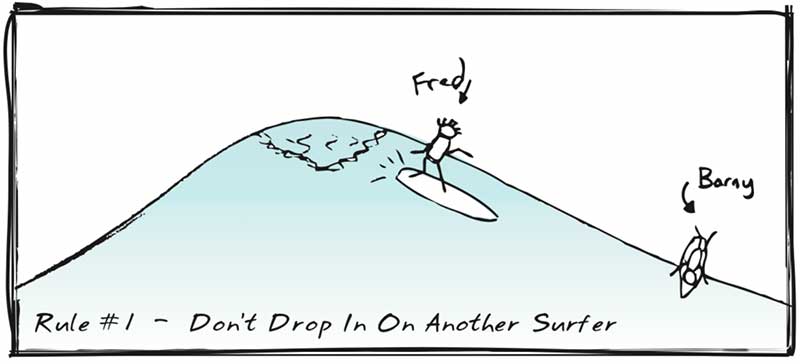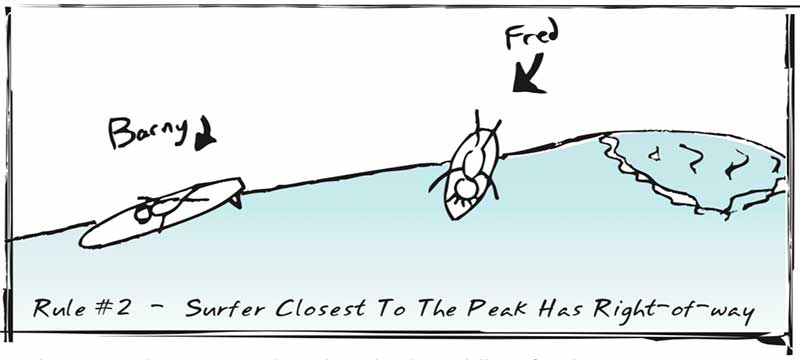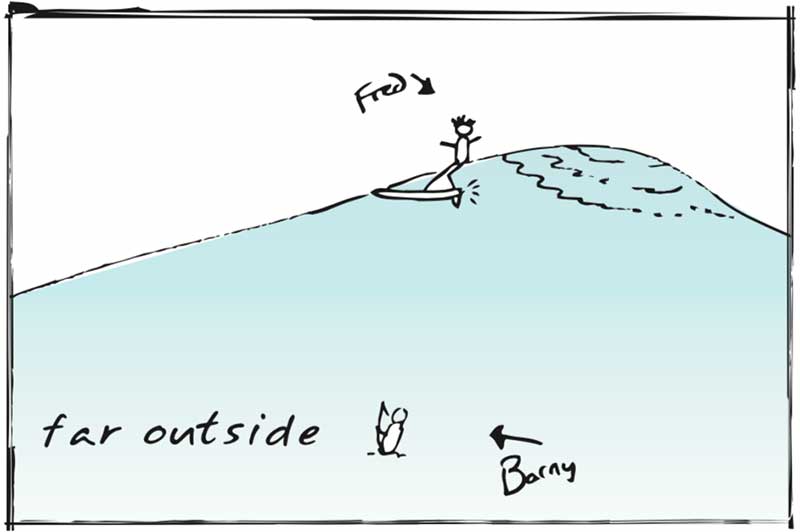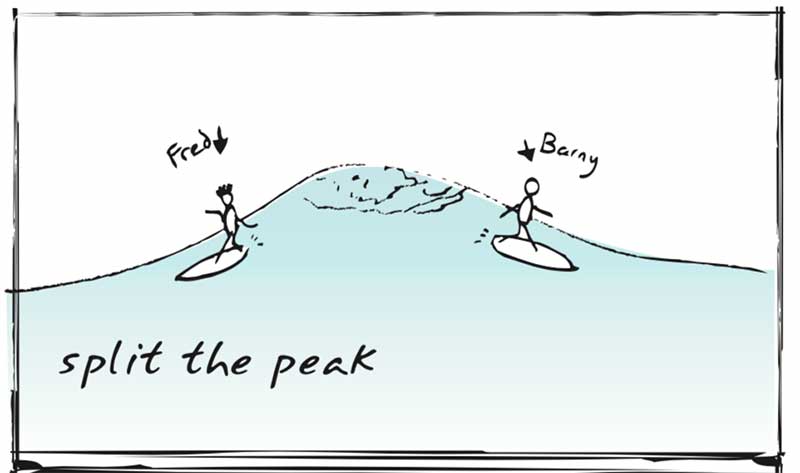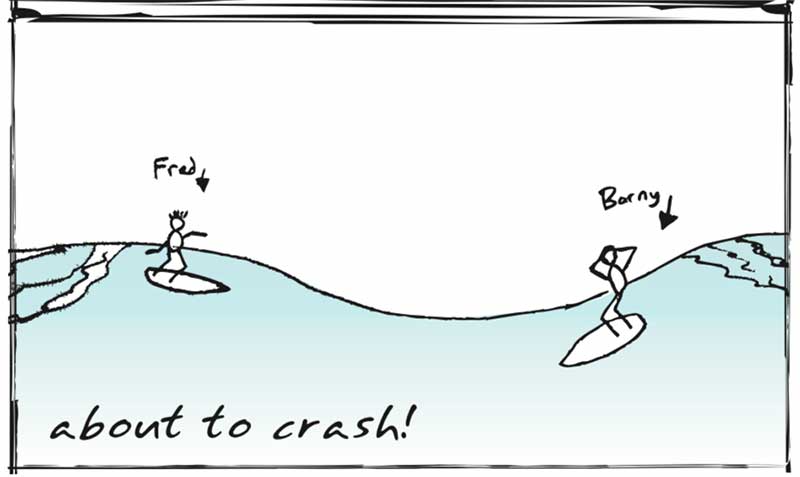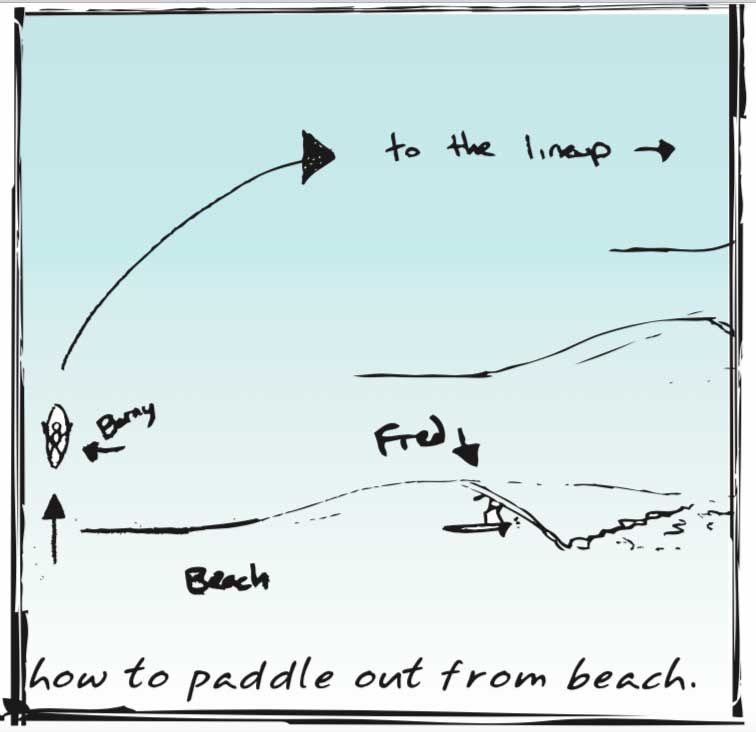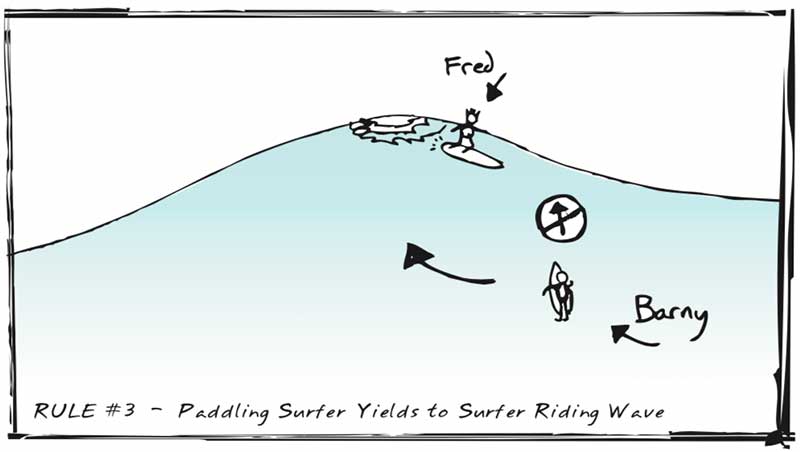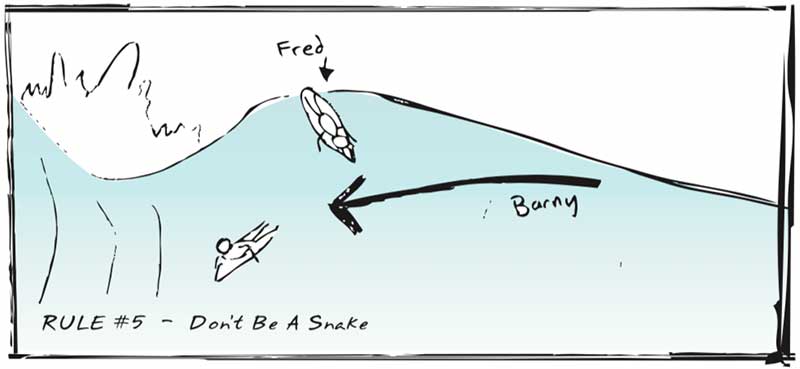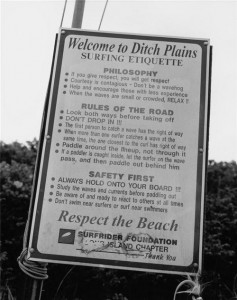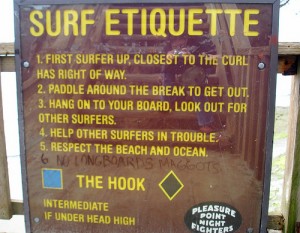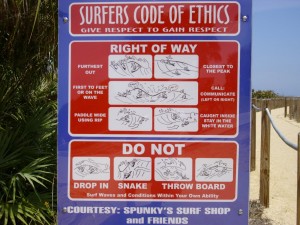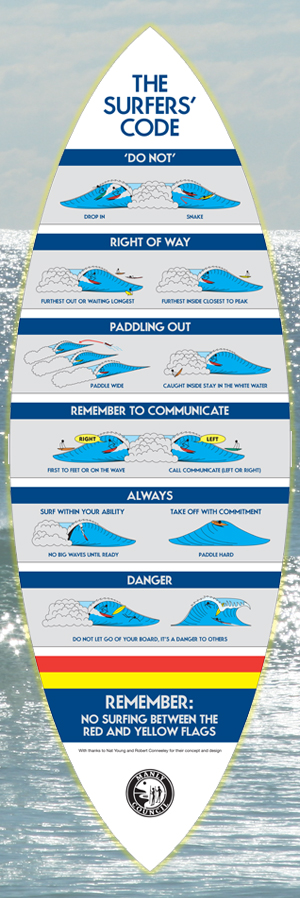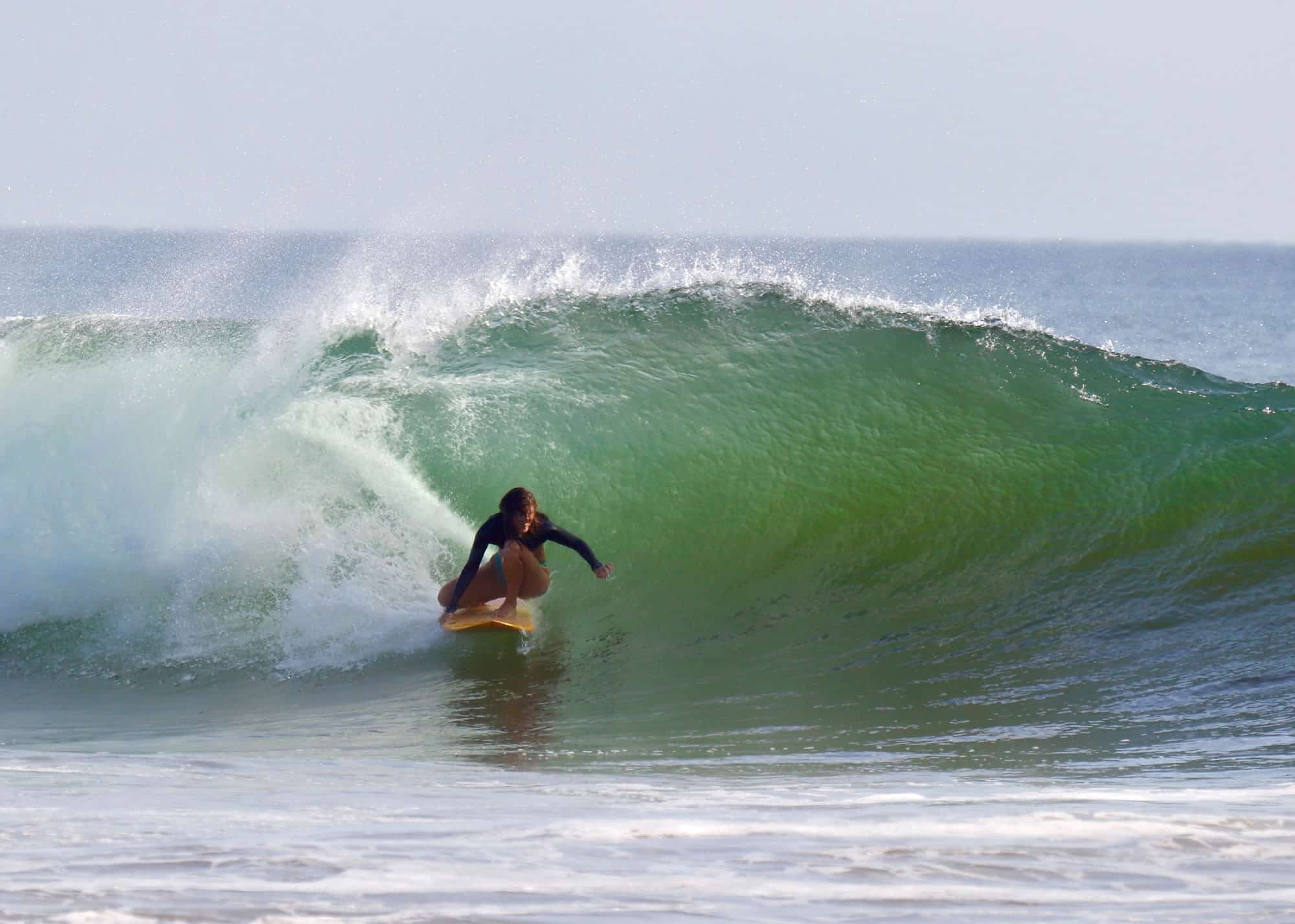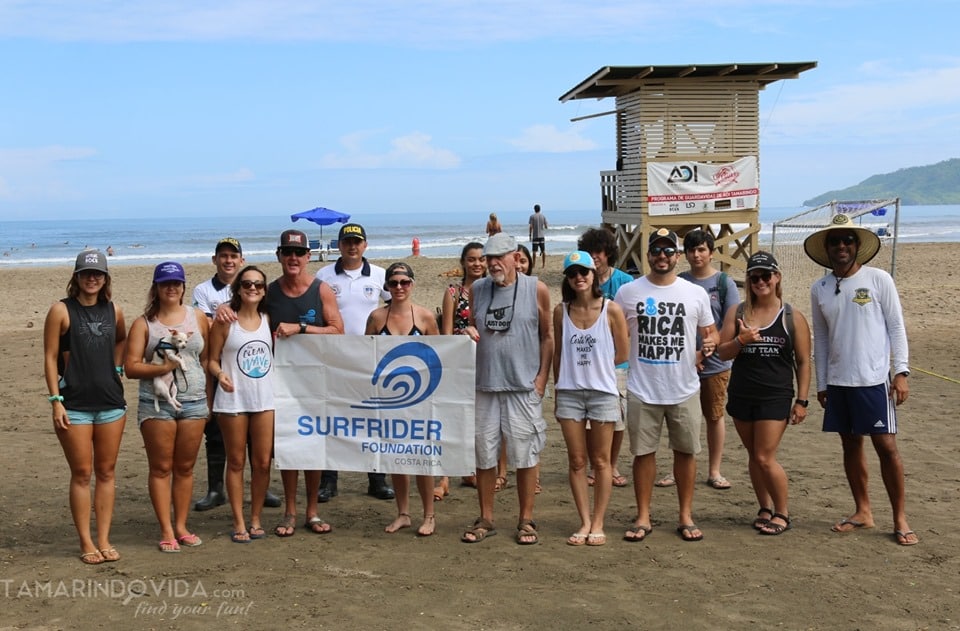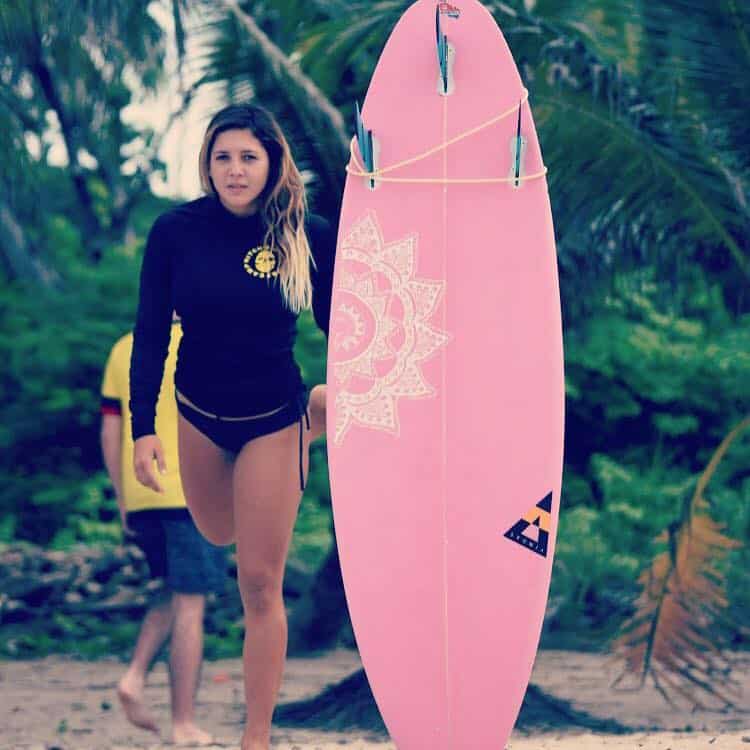Surfing Etiquette can be described as the official list of rules for the sport of surfing. Having these rules allows us all to surf in harmony with one another. If there were no rules to surfing the lineup would be total chaos!
For this blog I researched the Internet and read all of the top books on “Learning to Surf”. I was amazed at how little focus had been put on the subject. These truly are the golden rules to surfing, they are so important!
Before We Begin , Please Review These Surfing Terms:
“closeout” – a wave or a large section of a wave that breaks at the same time, making it impossible to continue surfing the open face of the wave
“deep” – the steepest part of the shoulder closest to the peak of the wave is considered the deepest part of the wave. Often when a surfer is “too deep” they are unable to drop in to a wave without falling off of their board
“down the line” – along the face of the wave
“duck dive” – a technique used to paddle out past a breaking wave. Arms push the nose of the surfboard down while the knee or foot pushes down on the tail as the surfer dips below the passing wave
“face” – the open, unbroken part of a wave
“green wave” – an open wave allowing the surfer to surf along the face of the wave, going either left or right parallel with the beach instead of straight towards the beach
“inside” – when paddling for a wave, “inside” refers to the person closest to the peak of the wave. “Inside” also refers to the shallower part of the water closest to shore.
“kick out” – to surf out of the wave, ending your ride (also called flicking out)
“lineup” – the area where the waves normally begin breaking. Surfers sit on their boards in the lineup and wait for waves to break.
“longboard” – a longer, wider, thicker surfboard. Longboards catch waves much easier than shortboards but are harder to control and turn.
“left” – a left is a wave that is breaking to the left. The direction “left” is used by the surfer when describing the direction of the wave while facing the shore. Therefore, from the beach, a “left” is described as a wave that breaks from left to right.
“outside” – when paddling for a wave, “outside” refers to the person further away from the peak of the wave. “Outside” also refers to the deeper part of the water, where the biggest waves break, further from shore.
“peak” – the immediately breaking part of the wave.
“right” – a right is a wave that is breaking to the right. The direction “right” is used by the surfer when describing the direction of the wave while facing shore. Therefore, from the beach, a “right” is described as a wave that breaks from right to left.
“section” – a part of a wave. When a surfer “makes a section” a surfer is staying in front of a breaking section of the wave.
“set wave” – a larger wave (the largest waves usually break in sets of 2,3, or 4)
“shortboard” – a shorter, narrower, thinner surfboard. It is more difficult to catch a wave on a shortboard than it is on a longboard, but a shortboard can be controlled/turned much easier.
“shoulder” – the unbroken section of the wave directly next to the peak
“turtle roll” – a technique used to paddle a longboard out past a breaking wave. Longboards are generally too big to duck dive. With the turtle roll technique the surfer turns upside-down and propels the surfboard (also upside down) through the breaking wave.
“whitewash” – the broken white water of a wave moving straight towards shore
OK, and Now For the Rules.
There are 5 of them. Learn them. Know them. Love them. They will save your ass in the lineup time and time again.
Rule #1 – Don’t Drop In On Another Surfer
Rule #2 – The Surfer Closest To The Peak Has The Right Of Way
Rule #3 – Paddling Surfer Yields To Surfer Riding Wave
Rule #4 – Don’t Ditch Your Board
Rule #5 – Don’t Be A Snake
At Witch’s Rock Surf Camp, Surfing Etiquette is the first seminar we deliver to our students each week in our Beginner Surf School program. Students must learn these rules before ever paddling out in the lineup for the first time.
This blog is about to go DEEP.
Take your time, read the whole thing, and you’ll be an expert on the subject. And that makes me happy, because improving your surfing is why I wrote this!
Rule #1 – Don’t Drop In On Another Surfer
If you are paddling for a right and a surfer on your left is also paddling for it, you must yield to him or her
OR
If you are paddling for a left and a surfer on your right is also paddling for it, you must yield to him or her.
In the example below, Barny is paddling for a left, but a surfer on his right (Fred) already has the wave. Barny must yield to Fred.
Fred is closest to the peak and has the right of way. He is obviously standing and riding this wave. Barny should STOP paddling and get out of Fred’s way. If Barny continues to paddle for this wave, catch it, and start surfing in front of Fred, this would be called Dropping In. Dropping In is considered to be the cardinal sin of surfing. Dropping in on another surfer and obstructing or interfering with their right of way is dangerous and disrespectful. You just ruined their wave… and that is a pretty lame thing to do. Make sure you look both ways before dropping in every time you paddle for a wave.
What If You Accidentally Drop In On Someone?
If you accidentally drop in on someone, try to kick out of the wave as quickly as possible. If you lack board control, do your best to angle your surfboard towards and off of the shoulder of the wave. Don’t simply fall off of your surfboard as your board could run into the surfer riding the wave. Make sure to immediately apologize to the person you just dropped in on. If you can’t learn Rule #1 about surfing etiquette you have no right to be out in the lineup.
What If Someone Else Drops In On Me?
Unfortunately not everyone else in the water will read this. You can help minimize getting dropped in on by following this advice:
– When you have the right-of-way and are paddling for a wave, and someone outside of you is also paddling for the same wave, make a sound or whistle that means you are going to catch the wave. Make sure not to do this unless you are certain you will catch the wave, otherwise you will feel really stupid after calling someone off of a wave that you ended up not being able to catch.
– If you are riding a wave and someone drops in on you, make an even louder sound or hoot to let them know you are there. If they don’t kick out of the wave, do it again. If they still don’t get out of the wave, you can assume that they are a jerk and aren’t going to get out. It can be quite frustrating when someone else breaks the first rule of surfing etiquette, so do your best to keep your cool and enjoy the waves. There will always be another wave to surf!
– Let your surfing speak for itself. By becoming a better surfer, less people will drop in on you.
Is Dropping In On Someone Ever OK?
If you are next in line on a wave, you may drop in on the surfer riding the wave ONLY WHEN:
– YOU ARE CERTAIN that they have fallen.
– YOU ARE CERTAIN that they will not make the section between you and him/her.
– They have dropped in on you twice or more and they didn’t say sorry when they did it. (this last one is my personal rule and it really shouldn’t be considered part of the official rule)
As a beginning surfer, I would suggest that you never drop in on anyone for any reason. Many surfers are amazingly fast and can surf around large sections you may have thought impossible to make. You need to be extra careful not to give other surfers any reason to become upset with you. Also, as a beginning surfer you will find that other surfers will frequently drop in on you. Don’t get upset. Unless you can surf well enough to catch green waves, better surfers will take this opportunity to not let a good wave go to waste. If you are going straight and surfing the whitewash it is considered OK for better surfers to drop in on you as long as they don’t interfere with your wave.
Rule #2 – The Surfer Closest To The Peak Has The Right Of Way
In this example, Barny and Fred are both paddling for the same wave. It does not matter that Barny is on a longboard and can stand up and start riding the wave before Fred can. Fred is closer to the peak so therefore he has the right of way. It is acceptable for Barny to paddle for the same wave as Fred as long as he remains respectful of Fred by giving him distance and yielding to him should he catch this wave. Any pressure causing Fred to become “too deep” or otherwise unable to catch the wave is considered poor surfing etiquette and unacceptable.
Back in the earlier days of surfing everyone used to ride a longboard, and longboarders competed with other longboarders for waves. Rule #2 used to state that the first person paddling for the wave owned it. When the shortboard became popular in the 1970s, longboarders had an unfair advantage because their size and buoyancy allowed them to paddle and catch waves much earlier. Rule #2 was changed to state that it was the surfer closest to the peak of the wave, not the first surfer standing, that had the right-of-way. You will still find some conflict of opinion regarding this rule among some older longboarders at some of the mellower surf breaks, but in general you should abide to Rule #2 (especially at the more popular, crowded surf breaks).
What Happens When The Surfer Is Really Far Outside?
In this example, Fred is already up and riding the wave. He was much further outside that Barny was and he was waiting much longer than Barny was. Even though Barny is technically “inside” of Fred, Fred is much closer to the peak of the wave so he has the right of way. If someone is already up and riding, paddling into the wave behind them does not give you the wave.
What Happens When 2 Surfers Split the Peak?
If there are two surfers on opposite sides of a peak, they each have the right-of-way to take off on their respective sides.
In the example above, Fred is taking off on the right and should go right. Barny is taking off on the left and should go left. It is not acceptable to take off behind the peak unless there is nobody on the other side. Barny does not have right-of-way over Fred to cross over the peak and take the right.
What Happens When 2 Surfers Are On the Same Wave And Headed Towards Each Other?
In the example above, this wave is closing out towards itself and Fred and Barny are riding towards each other. Both Fred and Barny have the right-of-way because they are both closest to their respective peaks, but since they are about to run into each other they should both kick out or straighten out of the wave.
The general rule here is to be nice and allow the better surfer to utilize the wave in a way you hope to one day be able to. Since Fred surfs much better than Barny, Barny should kick out or straighten out and let Fred smack the lip or bust an air. Beginning surfers should use this opportunity to practice kicking out or straightening out. Don’t worry, one day you’ll be the guy/girl busting a big air off that close-out section!
Rule #3 – Paddling Surfer Yields To Surfer Riding Wave
When you are initially paddling out from the beach, don’t paddle straight into the heart of the lineup. If you do, you risk the chance of being in someone’s way when they are paddling for or surfing a wave. Instead, paddle out through a channel to the outside and THEN paddle parallel to the beach towards the lineup.
In the example above, Fred is nestled deep in this tube ride and there appear to be more waves like it behind this one. Barny knows that he does not want to ruin anyone’s wave so he makes sure to paddle out down the beach away from the breaking waves. Once Barny gets outside of where the waves are breaking he can then paddle parallel with the beach towards the lineup.
It is much easier to predict where the waves will be breaking when surfing a reef break or point break. When you are surfing a beach break, sand bars can shift and waves can break almost anywhere. You will inevitably find yourself paddling out and end up in front of a surfer riding a wave. What do you do?
Rule #3 states that the paddling surfer always yields to the surfer riding the wave. In the example above, Fred is surfing this left while Barny is paddling out and into his way. Barny should NOT paddle in front of Fred because he would be blocking Fred and potentially ruin his wave. Instead, Barny must paddle behind Fred and get hit by the whitewash or duck dive under it.
Yes, I know it would be easier to paddle over the shoulder of the wave instead of getting hit by the whitewash, but even a slight risk of ruining the surfer’s wave justifies this rule. There will inevitably be times when you end up in a bad spot and simply can’t paddle behind the surfer. In these cases, do your best to paddle fast as hell over the shoulder and out of the surfer’s way (and watch your toes!).
I suggest that true beginners remain far away from the main surfing lineup and focus on catching whitewash in the shallow inside. Once you are ready to catch green waves, try to find a less crowded wave away from the main surf break. Doing this while you learn will minimize the risk of paddling in front of a surfer and ruining their wave. If this happens (when this happens) make sure to apologize, which shows the surfer that at least you learned the rules of surfing and that you are trying. It happens to all of us from time to time.
Rule #4 – Don’t Ditch Your Board
If you want to paddle out in any lineup you must learn to control your surfboard at all times. You are not allowed to paddle out if you plan on ditching your surfboard whenever a big set comes in and scares you a little bit. Surfboards are large and heavy. Surfboards have sharp fins. Surfboards can do serious damage to other surfboards, other people’s heads, etc. And don’t rely on your leash because it or the leash cord could break at any time (especially with rental surfboards). Learn to duck dive or turtle roll so that you never have to ditch your surfboard.
Some personal advice: I suggest making sure that you are never paddling out directly in front of or behind another surfer. Try paddling out next to them, or give yourself at least 30 feet distance. A monster set wave could come from out of nowhere and break on everyone’s head, and even if you tried to duck dive you might just get WORKED and lose your board. Giving yourself some distance from other surfers, especially when you are paddling out, will help keep everyone safe.
Rule #5 – Don’t Be A Snake
When someone “snakes” you they are knowingly paddling around you in order to gain right-of-way on a breaking wave that you were already paddling for.
In this example, Fred is about to catch this wave while Barny paddles in front of him in order to be closer to the peak and catch the wave. Barny is snaking Fred. Don’t be a snake. Snakes get no respect in the lineup.
Being a snake, dropping in on others, aggressively jockeying for position in the lineup, or any other act of being a wave hog is considered rude. When you paddle out don’t immediately paddle outside past everyone else and try to get the first wave that comes in. Wait for a few waves to break first. Before you know it, the lineup will have been shuffled around a little bit and you will be in position for a wave. Just because you can catch all of the waves doesn’t mean you should (this applies especially to longboarders and stand up paddlers).
It’s Your Responsibility to Know the Rules
Here are some examples of Surf Etiquette signs found at local surf breaks around the world (click photos to enlarge):
Ditch Plains, Long Island, New York
the Hook, Santa Cruz, California
Manly Beach, New South Wales, Australia
Conclusion
These rules have been developed over decades for the safety and respect of everyone. Surfers may seem like a mellow bunch on land, but things can quickly get fiery in the water. Causing an injury to yourself or others out of ignorance of the rules is no different than if you jumped into a car without Driver’s Ed and promptly caused a crash. And remember, there are no police officers in the lineup to save you if you’ve royally pissed off the huge, angry, local surfer guy at your local break.
If you accidentally break one of these rules, make sure to apologize. Be sincere and learn from your mistake and you should be OK. Even if you’re not sure you were at fault, apologize, and make sure the other surfer is OK. Otherwise your board, your face, or your car might have serious problems (I wish I could say that surfing was less primal in the lineup but that just isn’t the case).
Again, here are the rules that you must know before ever paddling out into any lineup:
Rule #1 – Don’t Drop In On Another Surfer
Rule #2 – The Surfer Closest To The Peak Has Right-Of-Way
Rule #3 – Paddling Surfer Yields To Surfer Riding Wave
Rule #4 – Don’t Ditch Your Board
Rule #5 – Don’t Be A Snake
Learn these rules of surfing etiquette and you will enjoy the waves safely, with confidence, and with respect from your fellow surfer.
P.S. Learning How To Surf Can Really Suck.
When you try learning to surf on your own, you waste your time getting nowhere. You have a much higher chance of getting hurt. And let’s be honest, nobody likes feeling like a kook.
So if you’re ready to conquer surfing, I definitely recommend you check out the Beginner Surf School program at Witch’s Rock Surf Camp. You’ll learn skills in days that normally take months to figure out. And you’ll have a blast.
Just imagine being able to paddle out next week and catching tons of waves at your home break or any surf spot around the world…
I’ll see you out in the water.
pura vida,
Joe Walsh


